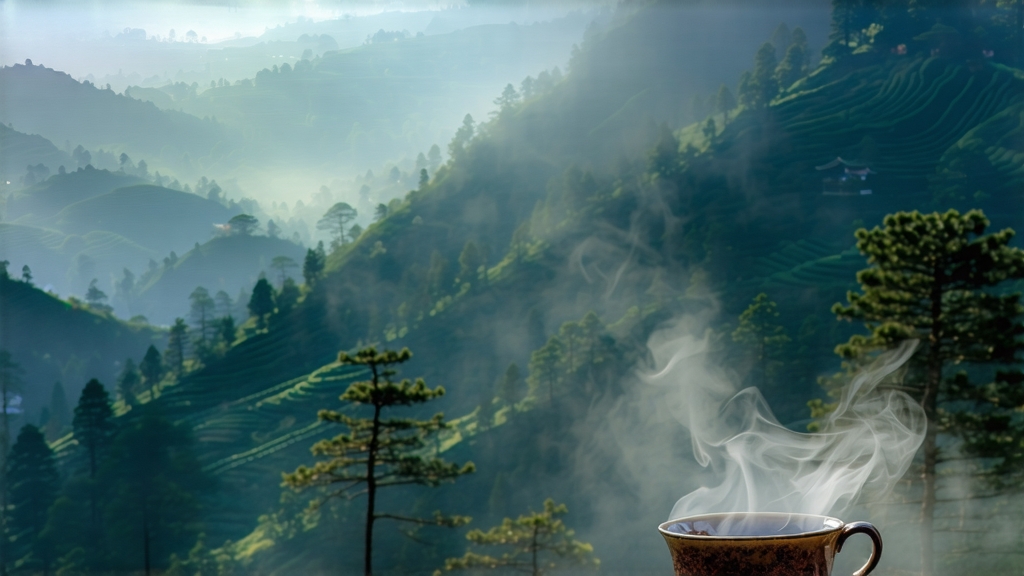
Long before English breakfast blends and afternoon tea services, there was Lapsang Souchong—an assertive, pine-smoked black tea that sailed out of the Wuyi Mountains in 1646 and rewrote the global story of tea. Today the name evokes everything from campfire romance to polarizing campfire criticism, yet few drinkers outside China realize that the original leaf is subtle, sweet and laced with longan fruit notes, nothing like the tarry “liquid bacon” caricature often sold abroad. To understand Lapsang Souchong is to witness how one Fujian village accidentally invented black tea, gave Europe its first taste of fully oxidized leaves, and still guards a craft that balances smoke, fire and time.
History: From Ming-Era Flight to London Parlours
Legend places the birth of Lapsang Souchong at the end of the Ming Dynasty, when Qing soldiers forced tea farmers in Tongmu village to abandon their freshly picked green tea. Returning days later, the farmers found the leaves had withered and oxidized. To salvage the crop they dried the leaves over hastily built pine fires; the resulting tea, dark and fragrant, was rushed to market in Xingcun where Dutch traders paid double the usual price. By the early 1700s the East India Company had rebranded the tea “Bohea Souchong,” shipped it past Cape Hope, and planted the fashion for black tea in London coffee-houses. Catherine of Braganza’s dowry chest supposedly contained a small tin; Samuel Pepys wrote of “a cup of Souchong, very good and comforting.” Thus a village emergency became the prototype for every black tea that followed.
Micro-Terroir: Why Only Tongmu Can Be “Original”
The Wuyi Mountains rise like stone battlements above the Fujian-Jiangxi border, trapping moist monsoon clouds that shroud the granite cliffs in perpetual fog. In the narrow gorge of Tongmu, altitude (600–1 200 m), diurnal swings of 15 °C, and mineral-rich runoff create a stress environment that condenses amino acids and sugars in the spring buds. Only here can the indigenous Xiao Ye Zhong (“small-leaf seedling”) varietal deliver the honeyed base that accepts smoke without turning acrid. Chinese law formalised the link in 2002, granting Tongmu Protected Origin Status; leaves picked outside the gorge, even if pine-smoked, may not carry the coveted “Zheng Shan” (Original Mountain) prefix.
Harvest Grades: Not All Smoke Is Equal
International markets often treat “Lapsang” as a single commodity, yet within Tongmu the tea is sorted into four grades determined by pluck standard and distance from the smoking sheds.
- Zheng Shan Xiao Zhong – picked the day before Grain Rain from single buds plus the first unfolded leaf, smoked for only 2–3 hours over embers of 60-year-old Masson pine. The cup is burgundy-amber, the aroma a whisper of pine resin behind longan and roasted sweet potato.
- Wu Zhong – a two-leaf-and-bud pluck smoked for 5 hours; deeper colour, maltier body, the choice of local gongfu drinkers.
- Yan Xun (“smoke scenting”) – third-leaf material smoked 8–10 hours, destined for Russian caravan blends.
- Wai Shan – leaves bought from neighbouring counties, heavily smoked to mask vegetal roughness; this is the “campfire” version most Europeans either love or hate.
Craft: Turning Green into Smoke-Kissed Black
Processing begins at 3 a.m. when pickers carry bamboo baskets up lantern-lit trails. By 7 a.m. the leaves are withering on slatted racks inside the second floor of three-hundred-year-old wooden houses; pine logs smoulder in open hearths below, sending warm air and resin upwards. After 4–5 hours the leaves are soft enough to roll, a step once done by barefoot treading but now performed with gentle machine curling that breaks cell walls and jump-starts oxidation. The crucial “fermentation” follows in cloth-lined piles where temperature is judged by hand—when the leaf vein turns copper-red and releases a ripe-apple perfume, the tea master declares the moment. Final drying occurs on bamboo trays set over pinewood embers; the depth of smoke is controlled by dampening the fire with fresh pine needles, releasing aromatic oils that bond to the leaf surface. Once cooled, the tea rests in earthen jars for 30 days so smoke